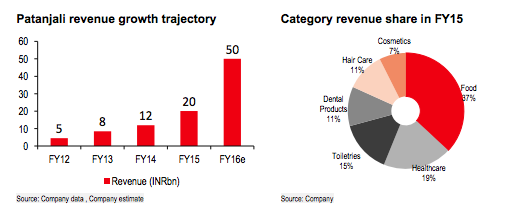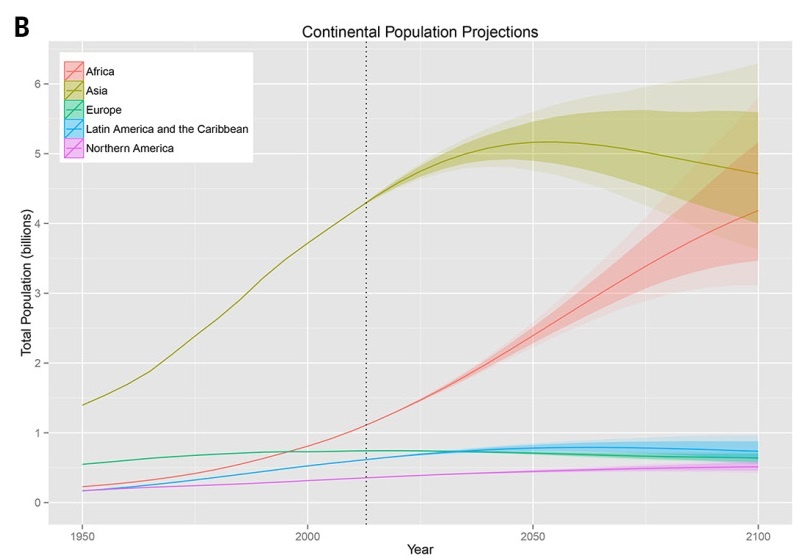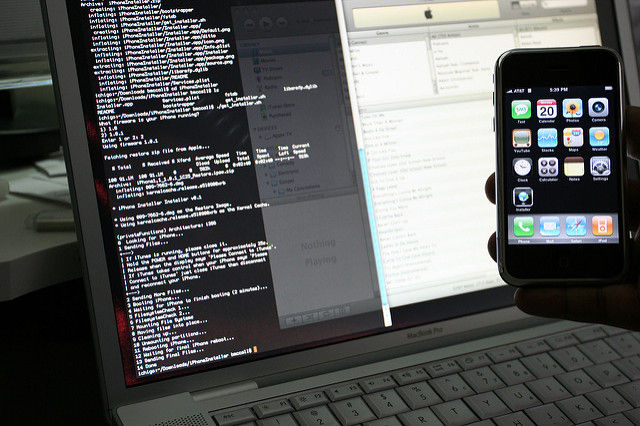From the FRB's FEDS Notes, March 22, 2016:
Unraveling the Oil Conundrum: Productivity Improvements and Cost Declines in the U.S. Shale Oil Industry
Ryan Decker,
Aaron Flaaen, and
Maria Tito 1
Oil prices have declined by roughly 70 percent since peaking in
the middle of 2014. The U.S. oil rig count--a common measure of drilling
activity--peaked in late 2014 and has since declined by about 60
percent. Yet U.S. production of crude oil continued rising until the
middle of 2015 and has since fallen by only 6 percent from its peak. The
dramatic advance of U.S. oil production seen in the last decade--driven
primarily by new discoveries of shale oil and innovation in drilling
and extraction technology--has not been as responsive to the
deterioration of oil markets as some analysts predicted.
2
Why have large declines in prices and in the rig count not
triggered a more dramatic decline in production? At what price level
would a large share of U.S. shale oil production lose economic
viability? In this note, we explore these questions with a focus on the
U.S. shale oil industry in the Bakken, Eagle Ford, and Permian Basin
regions.
3
We describe large productivity improvements in drilling and fracking
methods that have allowed production to remain strong despite falling
rig usage. We then document cost declines that have preserved
profitability for many firms even in the midst of historically low
prices.
The Resilience of Production
The dramatic increase in total U.S. oil extraction between 2011
and mid-2015 was driven almost entirely by unconventional production in
geologies such as shale; these areas now account for more than half of
U.S. output. The recent decrease in extraction has likewise been
concentrated in unconventional production.
4
This decline has been moderate in light of the large collapse in prices
and in the rig count. One explanation for the modest response of
production to the deterioration of the oil market is the high pace of
productivity growth seen by the shale extraction industry in recent
years.
| Figure 1. Rig Counts and Wells per Rig, Bakken Region |
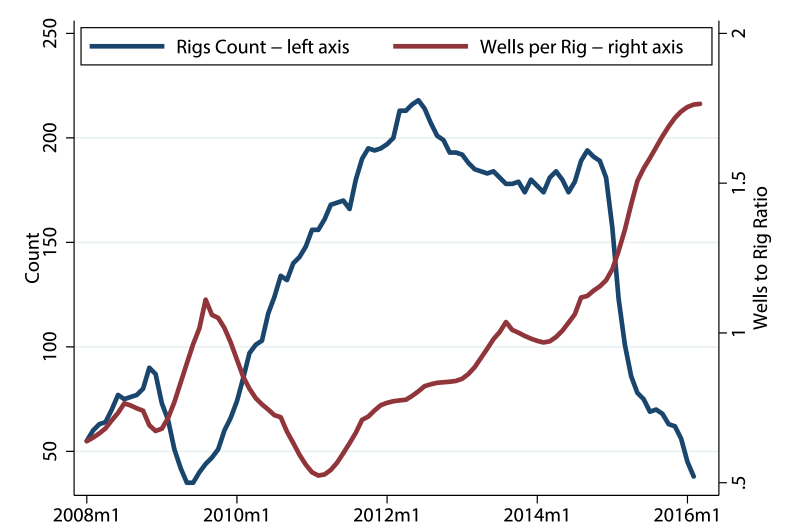 |
Improvements in the number of wells a rig can drill each month and
in the average length of each well have contributed to the productivity
gains in drilling. As shown in Figure 1, which plots data for the
Bakken region, the number of wells drilled per rig in a given month has
risen steadily since 2011, and it accelerated further after the rig
count began falling in 2014.
5
The main driver of this greater rig efficiency is the adoption of pad
drilling technology whereby a rig can drill multiple wells from the same
spot without the need for expensive and time-consuming disassembly,
relocation, and reassembly. Additionally, each well has become much
larger, as the average well length has doubled from roughly one to two
miles (American Petroleum Institute (API) 2015,
Quarterly Well Completion Report. IHS Global Inc.).
Increased and more efficient use of water, sand, and other
proppants in the fracking process has further enhanced the productivity
of oil wells, particularly early in the well lifecycle.
6
As a result, in addition to the increase in the number of new wells per
rig, the extraction from these new wells in their first month of
production has roughly tripled since early 2008.
7 These improvements can be best illustrated by examining well decline curves, which track productivity over a well's lifecycle.
| Figure 2. Average Well Decline Curve by Cohort |
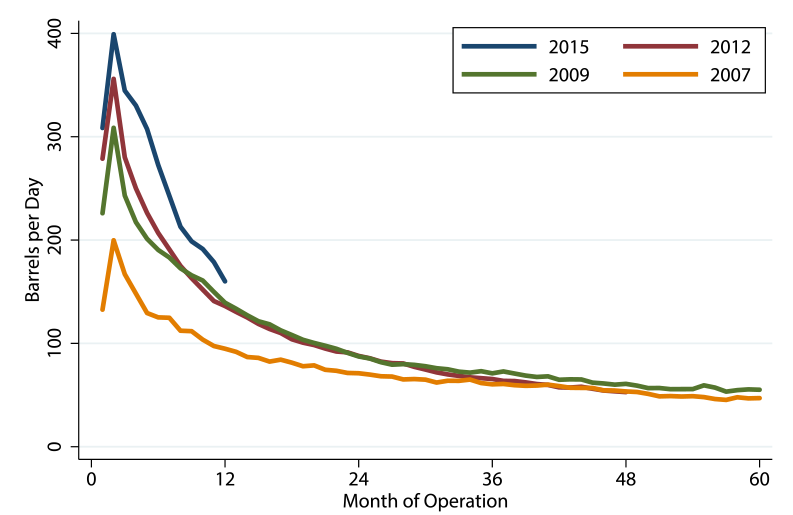 |
To facilitate a more disaggregated analysis, we use well-level
data for the Bakken region from the North Dakota Department of Mineral
Resources. These data provide monthly production by well in addition to
other well characteristics and account for roughly 95 percent of total
Bakken oil production. Figure 2 plots well decline curves for selected
well cohorts, defined by year of drilling, in the Bakken region. The
y-axis reports average well output in barrels per day. The x-axis tracks
months of operation--the well lifecycle. The changes in productivity of
wells in early months of production are striking: output during the
first full month of production has roughly doubled since 2007. The
series of upward shifts in productivity paths seems to persist
throughout the lifecycle across subsequent well cohorts. While
innovations in fracking technology are primarily thought to shift
production forward in the well lifecycle (rather than to increase total
lifetime output), well-level data suggest that output in later-producing
months has actually increased in recent years.
| Figure 3. Well Decline, Controlling for Well Size |
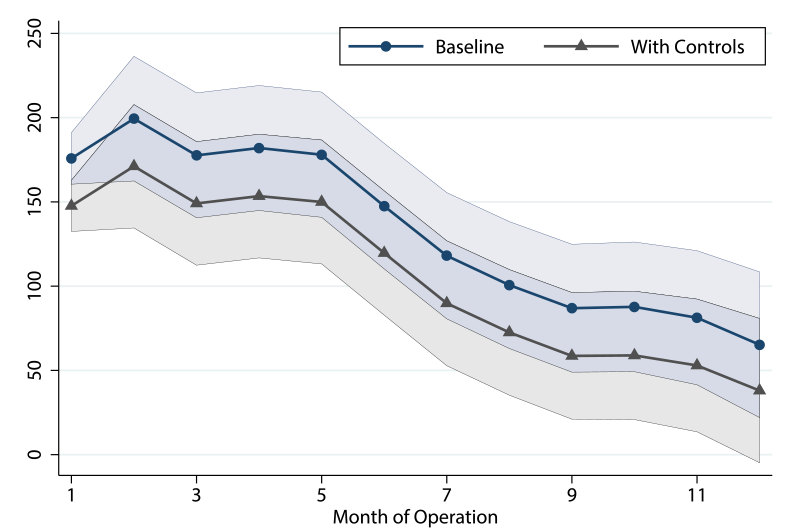 |
How much of this increase in productivity is driven solely by
expansions of well size, as opposed to innovations in fracking
technology? Using data for the Bakken region, we regress well-level
output on a series of monthly indicators that are distinct for each
cohort year. The resulting cohort-specific well-decline coefficients
capture the change in output along each month of operation compared to a
baseline year, for which we choose 2007. The coefficients for the
cohort of 2015 are shown in blue in Figure 3. (Notice they are roughly
equal to the difference in the well decline curves between 2015 and 2007
in Figure 2.) Next, we add a measure of well size to the regression,
specifically, the lateral distance of a well that undergoes perforations
in preparation for fracking. As shown in grey in Figure 3, these
adjusted coefficients are not largely different from the raw
coefficients without the well-size adjustment. This analysis points to
innovations apart from increases in well size as the main contributing
factors to the output gains evident from Figure 2.
| Figure 4. Decomposition of Production Changes |
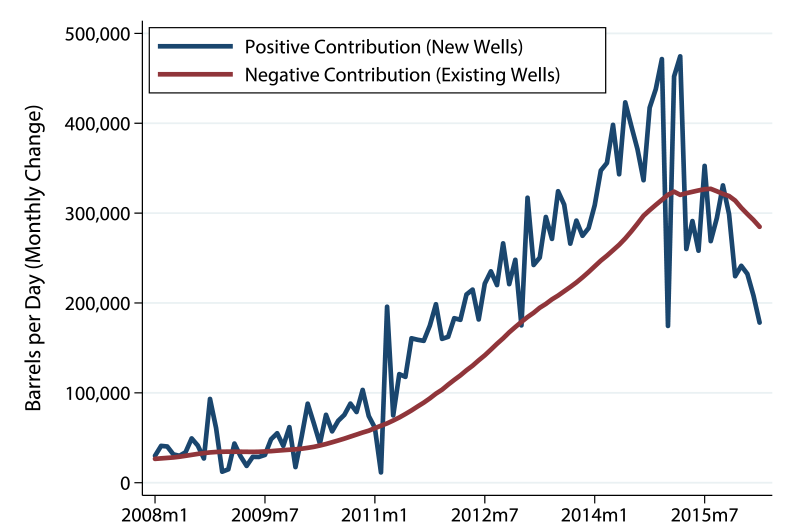 |
Other lifecycle and composition issues can provide further
insights into aggregate production. Figure 4 decomposes the change in
monthly oil production from all regions into the positive contribution
of new wells (the blue line) and the negative contribution from existing
wells (the red line), the latter being almost invariably negative as a
result of the natural lifecycle declines depicted in Figure 2.
Consequently, aggregate production increases whenever output from new
wells (the blue line) exceeds the natural output declines among existing
wells (the red line). Despite productivity improvements, output from
new wells began falling in mid-2015 as the number of well completions
dropped significantly. This pushed the positive contribution from new
wells below the negative contribution from existing wells, resulting in
aggregate production declines. It is noteworthy, though, that the drag
from existing well declines peaked shortly thereafter, mitigating the
fall in aggregate output. Completions of larger wells and productivity
improvements among legacy wells have softened the negative pull from
existing wells.
| Figure 5. Rigs Needed for Flat Production |
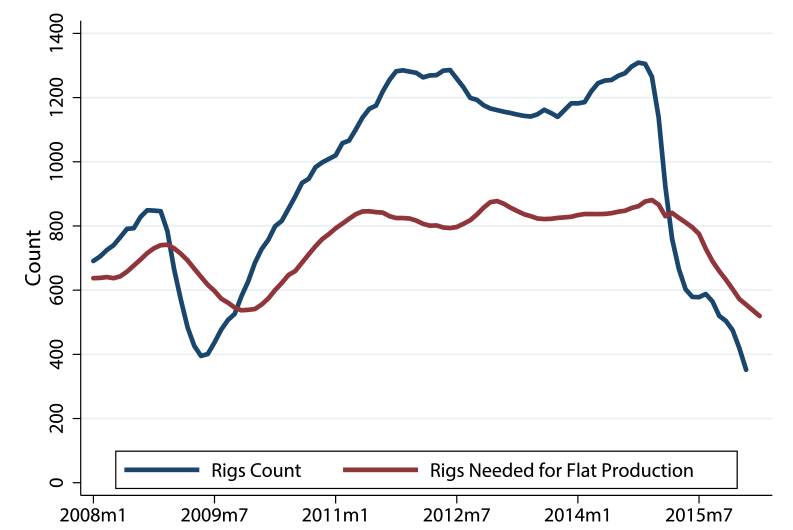 |
Figure 5 provides another way of understanding composition effects
behind production, the number of rigs needed to maintain a constant
production level, that is,
rigs needed for flat production (RNFP).
This measure is constructed by calculating the number of new rigs
necessary to offset observed declines from existing wells, using the
prior month's estimate of new production per rig. As rig efficiency has
increased and legacy-well decline curves have shifted up, and as total
production has gradually fallen, the RNFP has declined. This framing
highlights a decreasing usefulness of the rig count as a sole indicator
of overall activity.
General equilibrium mechanisms have also affected the oil
production climate. Lower drilling activity combined with productivity
enhancements have reduced the demand for workers, and wages of workers
in the Natural Resources and Mining sector have declined by 10 percent
or more in the three main shale regions.
8
Service costs have fallen by about 30 percent in the shale regions
(Curtis 2015), with anecdotal reports even indicating that some service
firms are performing tasks for free to retain market share. Diesel fuel
and other energy sources are key production inputs, and their costs have
fallen mechanically with oil prices. Using cost share estimates from
the Energy Information Administration (EIA) from 2009, we construct a
back-of-the-envelope estimate that labor, services, and fuel cost
reductions have collectively reduced overall production costs by more
than 10 percent.
9
Other costs have fallen with broad market conditions as well, most
notably royalties and taxes (which often depend nonlinearly on prices).
10
Additional productivity improvements and cost reductions have
resulted from the aggressive reallocation of drilling and operating
activity toward high-productivity plays and rigs as well as from the
failure or acquisition of low-productivity, high-cost firms.
11
Considering the recent productivity improvements, how should we expect
aggregate production to evolve in coming months and years? The EIA,
accounting for the various productivity and lifecycle factors described
above, forecasts total U.S. oil production to gradually fall to about
8.2 million barrels per day in early-2017, flattening out thereafter
(U.S. Energy Information Administration 2016b).
Economic Viability of Shale Production
In recent years, companies have made extensive efforts to reduce
drilling and production costs. Cost estimates vary widely, reflecting
substantive variation in regional and company-specific costs, ambiguity
about the details of cost estimation, and general uncertainty. Our goal
is to generate a range of estimates that can inform our view of the
economic viability of continued shale oil production....
MORE
HT:
The Big Picture

